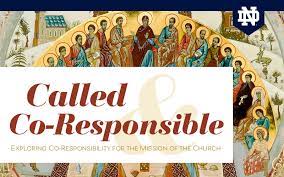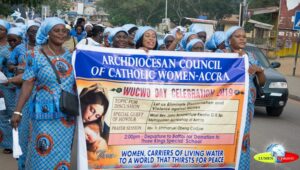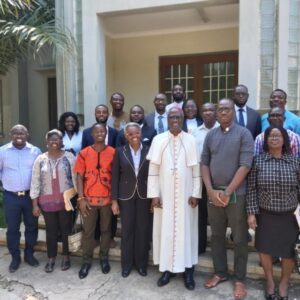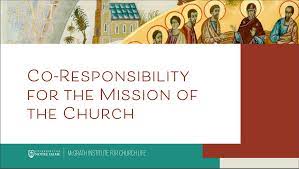There are two accomplishments of Vatican II that, in my view, were never implemented fully, and perhaps in the one case, never implemented at all. The latter is the theology of revelation we find in Dei Verbum. The former is the ecclesiology, the theology of the Church, set out in Lumen Gentium and other documents. To bring up the topic of “co-responsibility for the being and mission of the Church” as Pope Benedict has done, is to invoke this ecclesiology as an arrested development, a vision never fulfilled, a task never completed.
That Benedict was doing this is clear from the context he sets for the idea in the major address in which it comes up, his 2009 Address to the Pastoral Convention of the Diocese of Rome, speaking as the local bishop in his cathedral, the Lateran Basilica of St. John, with the title, “Co-responsible for the Church’s Being and Action,” and the subtitle “Church Membership and Pastoral Co-responsibility.” The context of the speech is the Diocese of Rome’s renewed commitment to the priority of pastoral work in the local parishes. Benedict remarks that,
This commitment . . . must be based on a renewed awareness of our being Church and of the pastoral co-responsibility which, in Christ’s name, we are all called to exercise. And it is precisely on this aspect that I would like to reflect now.
“The Church,” he says,
Which originates in the Trinitarian God, is a mystery of communion. As communion, the Church is not merely a spiritual reality but lives in history, so to speak, in flesh and blood. The Second Vatican Council describes her “in the nature of sacrament, a sign and instrument, that is, of communion with God and of unity among all men” (LG §1.1). This communion is captured under the twin images of the “People of God” and the “Body of Christ,” where “People of God” expresses the continuity of the Church’s history, [and] “Body of Christ” expresses the universality inaugurated in the Cross and in the Lord’s Resurrection.”
Continuing with Benedict’s Address just a little farther, he ponders further the mystery of the Church as carried in these twin images, and shows how they converge in, and are an effect of, the Eucharist:
Risen, Christ unites us all in the Sacrament to make us one Body. Thus the concept “People of God” and “Body of Christ” complete one another: in Christ we really become the People of God. “People of God” therefore means “all,” from the Pope to the most recently baptized child.
Within this one People,
The First Eucharistic Prayer . . . distinguishes between servants “we, your servants” and “plebs tua sancta”; therefore should one wish to make a distinction, one should speak of servants and plebs sancta, while the term People of God’ expresses the Church all together in their common being.

The discussion of “co-responsibility” which follows is thus set up as a discussion about the relationship of two categories of people to the mission of the Church and to each other. Specifically, the hierarchy is ordered toward serving the plebs. This relationship needs to be examined in the light of the fact that, as Benedict says,
The reawakening of spiritual and pastoral energies that has been happening in recent years has not always produced the desired growth and development. In fact it must be noted that in certain ecclesial communities, the period of fervour and initiative has given way to a time of weakening commitment, a situation of weariness, at times almost a stalemate.
To Benedict, this indicates that the ecclesial vision of the Council was never fully implemented: “This fact,” he says, “tells us that the luminous pages which the Council dedicated to the laity were not yet sufficiently adapted to or impressed on the minds of Catholics or in pastoral procedures.” He continues,
On the one hand there is still a tendency to identify the Church unilaterally with the hierarchy, forgetting the common responsibility, the common mission of the People of God, which, in Christ we all share.
On the other hand, he says,
The tendency still persists to identify the People of God unilaterally, . . . in accordance with a merely sociological or political concept, forgetting the newness and specificity of that people, which becomes a people solely through communion with Christ.
In other words, he is saying, to think of the Church as merely in history, a secular organization essentially, rather than a mystery of communion which is both visibly in history, as visible as, say, Amtrak, but, unlike Amtrak, transcends history. That is why the Church is an article of faith and not simply a matter of observation.
It is precisely at this point in the speech that the idea of co-responsibility is raised: “Dear brothers and sisters, it is now time to ask ourselves what point our Diocese of Rome has reached. To what extent is the pastoral co-responsibility of all, and particularly of the laity, recognized and encouraged?” Recalling past centuries, in which “thanks to the generous witness of all the baptized who spent their life educating the new generations in the faith, healing the sick and going to the aid of the poor, the Christian community proclaimed the Gospel to the inhabitants of Rome.” It is this same mission of proclamation and evangelization that Benedict highlights as the object of co-responsibility for the being and acting of the Church.
One of the fruits of the Diocese of Rome’s heightened attention to the pastoral work of the parishes, he says, was that it:
Helped to develop in the parishes, religious communities, associations and movements a consciousness of belonging to the one People of God which, as the Apostle Peter said, God made his own: “that you may declare the wonderful deeds of him”(1 Pt 2: 9).

To cite this verse is to invoke the People of God as a royal priesthood, with each member sharing, on the basis of his or her baptism, in the priesthood of Christ: “But you are a chosen race, a royal priesthood, a holy nation, God’s own people, that you may declare the wonderful deeds of him who called you out of darkness into his marvelous light.” The theology of co-responsibility begins by invoking Vatican II’s rediscovery of the priesthood of the baptized, the mystery of the People of God as a royal priesthood, with each member ordered towards the prophetic, royal and priestly vocation to “declare the wonderful deeds of him who called [us] out of darkness into his marvelous light,” that is, to mission, to evangelisation.
Benedict comments wryly, “There is still a long way to go . . . Compared to the number of inhabitants in each parish, the lay people who are ready to work in the various apostolic fields . . . are still few and far between.” In other words, where are the lay leaders in the mission of the Church, the lay-led projects, the lay-led initiatives, the work of the “sancta plebs,” as served by the hierarchy? What is needed to foster it?
In the first place, he says, we have to improve everyone’s formation so that it is “more attentive and focused on the vision of the Church,” and this goes for everyone, “on the part of priests as well as of religious and lay people to understand ever better what this Church is, this People of God in the Body of Christ.” Note the necessity of a deeper contemplation and reception of the mystery of the Church, without which this formation is not possible. But given that necessity, it also implies another, namely, “to improve pastoral structures in such a way that the co-responsibility of all the members of the People of God in their entirety is gradually promoted, with respect for vocations and for the respective roles of the consecrated and of lay people.”
So, co-responsibility is not just about lay people. Yet, the way we think about lay people in relation to the mission of the Church is a crucial piece of the puzzle. This needed improvement of pastoral structures, Benedict says,
Demands a change in mindset, particularly concerning lay people. They must no longer be viewed as “collaborators” of the clergy but truly recognized as “co-responsible” for the Church’s being and action, thereby fostering the consolidation of a mature and committed laity.
The question of co-responsibility of lay people is a key part of the overall question of leadership in the mission of the Church because it is a function of the larger question not simply of lay people, but of the relationship between the priesthood of the baptized, conferred by baptism, and the priesthood, “different by essence and not just by degree,” of the ordained minister.
We can see this from the very next sentence of Benedict’s speech that the theology of co-responsibility really resolves itself into a theology of the relationship between the royal priesthood of the baptized and that of the priesthood not derived from baptism but from the sacrament of Orders:
This common awareness of being Church of all the baptized in no way diminishes the responsibility of parish priests. It is precisely your task, dear parish priests, to nurture the spiritual and apostolic growth of those who are already committed to working hard in the parishes. They form the core of the community that will act as a leaven for the others.

There is an image of lay leadership here. Benedict singles out true leaders in the mission of the Church, non-ordained, members of the “holy plebs” who are served by the ordained in the servant leadership proper to the exercise of their (ordained) priesthood. There is a leadership role, intrinsic to the royal priesthood of the baptized, and thus applicable to lay people and religious, and there is a leadership role, intrinsic to Holy Orders, which is ordered toward the service of the leadership of the “plebs.” That, in a nutshell, is the ecclesiology from which the idea of “co-responsibility” is developed, rooted in the recovery of the priesthood of the baptized and a corresponding renewed appreciation of the ordained priesthood in relation to it, from Lumen Gentium.
Pope Francis’s Evangelii Gaudium is basically this very same vision on steroids. The Address of Benedict emphasizes throughout a focus on evangelization, and Francis takes this over with spirit and power. He reiterates that evangelization is the “’first task’” of the Church (EG §15, citing John Paul II). Further, just as Benedict did, Francis insists that the task of evangelization belongs to the whole Church: “Evangelization is the task of the Church” (EG §111), and he goes on to echo Benedict in saying the Church is a “mystery rooted in the Trinity,” and yet existing “concretely in history is a people of pilgrims and evangelizers, transcending any institutional expression, however necessary” (ibid.). Here is the same balance we observed in Benedict—the Church as a mystery of communion visible as an empirical historical reality but not, like Amtrak, reducible to it. The Church exists for love of the world—for God so loved the world (Jn. 3.16)—and so it must be in the world, yet for that very reason, as Benedict had explained, it is not reducible to a socio-political organization, essentially a secular power structure.
Evangelisation has as its priority, Francis says, the “‘primacy of the proclamation of Jesus Christ’” (EG §110). This very primacy means at the same time our proclamation involves a call to a mystery of communion, expressed in time and space, in other words, a call to be a member of the Church, for, Francis reminds us, citing Lumen Gentium, “‘God has chosen to call [human beings] together as a people and not as isolated individuals,’” and “the people which God has chosen and called is the Church” (EG §113).
The ecclesial character of evangelization, as Francis explains it, comes from the grace (NB, §112, citing Benedict on the primacy of grace) of Baptism. The commission to evangelize is intrinsic to the Church as communion in the mystery of Christ’s death and resurrection, that is, it is intrinsic to Baptism: “In all the baptized, from first to last, the sanctifying power of the Spirit is at work, impelling us to evangelization.” Continuing, he says that “the people of God is holy thanks to this anointing” (EG §119), and in an allusion to 1 Pet. 2.9, he emphasizes that:
In virtue of their baptism, all the members of the People of God have become missionary disciples (cf. Mt. 28.19). All the baptized, whatever their position in the Church or their level of instruction in the faith, are agents of evangelization, and it would be insufficient to envisage a plan of evangelization to be carried out by professionals while the rest of the faithful would simply be passive recipients (EG §120).
This is a vision of leadership, and it arises not from participation in the specific ministry of the ordained and not as a function of Holy Orders, but from Baptism. Leadership in the “first task” of the Church, an ecclesial task, is not limited to a class of “professionals” within the Church. “Every Christian is challenged, here and now, to be actively engaged in evangelization; indeed, anyone who has truly experienced God’s saving love does not need much time or lengthy training to go out and proclaim that love” (EG §120). I find this incredibly refreshing. It seems to re-center the center of gravity in the Church away from the hierarchy, as the Church par excellence, to the baptized, called to evangelize, though not by setting up their own Church—for that would not be evangelization—but by inviting people into an encounter with Jesus Christ in and through ecclesial communion. For the grace of Baptism is not an absolute, stand-alone, self-referential gift. It is a configuration to the Paschal Mystery and hence to the sacrifice of Christ which is what constitutes the communion of the Church. Baptism is therefore intrinsically ordered towards Eucharistic communion.
Further echoing Benedict’s Address, Francis pays particular attention to lay people, who, he says, “are, put simply, the vast majority of the People of God. The minority—ordained ministers—are at their service” (EG 102). This is almost a direct echo of the “servant” / “plebs” distinction Benedict invokes, though “plebs” includes more than lay people, religious for example, even if the laity are a kind of synecdoche for it. Francis calls attention to the “responsibility of the laity, grounded in their baptism and confirmation,” and also echoing Benedict, he says that this responsibility has been very unevenly received and unevenly formed, due to various reasons. “In some cases,” he says, “it is because lay persons have not been given the formation needed to take on important responsibilities,” while in others, it is “due to an excessive clericalism” (EG §102). An “excessive clericalism” is, I take it, a description of the situation where, in people’s minds, both in and outside of the Church, “the Church” means the hierarchy.

What, then, is the theological and especially the ecclesiological foundation for a theory of co-responsibility? We already have the outlines of it from our consideration of the remarks of the two most recent Popes, but they have only based themselves on the documents of Vatican II. Lumen Gentium, in the chapter on the People of God, describes two priesthoods in the Church:
Though they differ from one another in essence and not merely in degree, the common priesthood of the faithful and the ministerial or hierarchical priesthood are nonetheless interrelated: each of them in its own special way is a participation in the one priesthood of Christ. The ministerial priest, by the sacred power he enjoys, teaches and rules the priestly people; acting in the person of Christ, he makes present the Eucharistic sacrifice, and offers it to God in the name of all the people. But the faithful, in virtue of their royal priesthood, join in the offering of the Eucharist. They likewise exercise that priesthood by receiving the sacraments, by prayer and thanksgiving, by the witness of a holy life, and by self-denial and active charity (LG §10).
There is a leadership associated with the hierarchical priesthood, that of pastoral governance, authoritative teaching, and sanctification, and that is clearly stated here. But it is important to note what is not stated. The hierarchical priesthood is not “more” of the same priesthood that the baptized have. It is not a super-priesthood, somehow completing, displacing or superceding the common priesthood. You cannot get “more” priestly than the priesthood which marks the whole Church. For that would be to imply that there is an inner Church of super-Christians, the hierarchy, and that, it seems, is the essence of clericalism. To say then, that the two participations in the priesthood of Christ differ in essence, that the difference is not a mere difference of degree, is important.
Ironically, perhaps, it is the Council’s documentation on the priesthood that offers the most promising resources for grounding and articulating our theory of co-responsibility. Presbyterorum Ordinis, the Vatican II Decree on the Ministry and Life of Priests, begins with inviting the reader to consider the mystery of the whole Church as a priestly body:
The Lord Jesus, “whom the Father consecrated and sent into the world” (John 10.36) gave his whole mystical body a share in the anointing of the Spirit with which he was anointed. In that body, all the faithful are made a holy and kingly priesthood. They offer spiritual sacrifices to God through Jesus Christ, and they proclaim the mighty acts of him who has called them out of darkness into his admirable light (see: 1 Peter 2:5, 9).
It turns out that Benedict and Francis start in the same place, an invocation of the mystery of the whole Church, because they are following Presbyterorum Ordinis. In this document, it follows directly from the above that “There is therefore no such thing as a member who does not have a share in the mission of the whole body. Rather, all of the members ought to reverence Jesus in their hearts (see: 1 Pet 3.15) and by the spirit of prophecy give testimony to Jesus,” thus justifying the priority that Benedict and Francis have given to evangelization as the first task of the Church in which all have a share. Benedict and Francis have carried this vision forward.
To support and indeed to build up the royal, priestly people and all of its members in their mission, such that its spiritual sacrifices are indeed made “through Christ,” another participation in the one priesthood of Christ, differing not in degree but in type from that conferred in baptism, is conferred by its own sacrament, the document continues, echoing but also amplifying Lumen Gentium:
The priesthood of presbyters, while presupposing the sacraments of initiation, is conferred by a special sacrament which, by the anointing of the Holy Spirit, puts a special stamp on them and so conforms them to Christ the priest in such a way that they are able to act in the person of Christ the head (PO §2).
This is, among other reasons, because “no Christian community is built up which does not grow from and hinge on the celebration of the most holy Eucharist” (PO §6), and in the Eucharist, Christ Himself acts, in the person of the ordained priest. The Church is a “sacrament—a sign and instrument of communion with God and of the unity of the entire human race” only “in Christ” (LG §1), and not on the basis of her own—our own—works or virtues. The Church is not held together by our works or virtues, but by the sacrifice of Christ, and that sacrifice is made present efficaciously in the Eucharist and in that way “makes” the Church (CCC 1396, cf. 1325), makes the One People of God. The sacrament of orders makes it so that the priest does not mediate himself, in his own person, as “head” of the community, but Christ, such that the presence of Christ is purely a function of Christ’s promise to be with us until the “close of the age” (Matt 28.20), a function of grace, and not in the first instance a human works or merit, which would make the Church a communion of our own making.
In perhaps the most sublime passage of PO, the Eucharist is described as the “source and summit of all preaching of the Gospel” (PO §5). In fact,
The other sacraments, and indeed all ecclesiastical ministries and works of the apostolate are bound up with the Eucharist and are directed towards it. For in the most blessed Eucharist is contained the entire spiritual wealth of the Church, namely Christ himself our Pasch and our living bread.
The building up of the Church is not just adding numbers to a humanly formed group through preaching—that is, proselytizing—but instead, preaching is directed towards incorporating people into the one Body—Christ’s Body not our “body”—into the one People of God—not “our” people—through their reception of the sacraments of initiation, ordered toward the Eucharist, by which people are fully incorporated (see CCC 1396) into the Body of Christ and his royal priesthood.
In other words, the ordained ministry is not ordered towards itself, but rather it is the priestly people towards which the ordained priesthood is ordered, and that priesthood retains its fundamental character as the share in Christ’s priesthood, which constitutes the Church. On the other hand, when the baptized exercise their royal priesthood in evangelization, it is not just to spread knowledge of the Word of God dislocated from its ecclesial home, for then it is not really a priesthood, since the communion of the Church is communion in Christ’s sacrifice. Evangelization is intended to bring people to the encounter with the Risen Lord which is incorporation into the Eucharistic body through configuration to Christ’s sacrifice.

The priesthood of the baptized, as a priesthood, flows from the one sacrifice of Christ and its exercise is thus intrinsically ordered towards it. That means it cannot be exercised fully apart from the ministry of the ordained, nor is it truly exercised if it tends toward the rupture of communion instead of towards building communion. This would include evangelizing activity that rejected the authoritative teaching of the magisterium, or undertaken in defiance of legitimate hierarchical authority. At the same time, it does not mean permission is necessary: “there is no need of a supplementary mandate from the hierarchy” to exercise the duty to proclaim Christ which comes “by virtue of the grace of baptism” (Torrell, 130). The two priesthoods are mutually inter-related, and thus we have co-responsibility for the being and acting of the Church.
On the one hand:
The best way to situate the priestly ministry within [the Church] as the wholly priestly people is . . . to emphasize that its service consists in making the royal or spiritual priesthood grow in such a way that, to speak like St. Augustine, the entire holy City of God may become a spiritual sacrifice agreeable to God through Jesus Christ (Torrell, 126).
The royal priesthood remains primary as the end towards which the ministerial priesthood is ordered: “The Christian minister is not defined uniquely in relation to the Eucharistic body, but also, by this very fact, to its mystical Body, of which he is put in charge at his own level of responsibility” (ibid.). On the other hand, the exercise of the baptismal priesthood is always to promote the spiritual sacrifice to which all people are called, and thus is ordered towards the communion of the Church, effected only through the sacramental ministry of priests. Torrell points out that “The Eucharist is presented not only as the center of the whole sacramental organism, but also as ‘the source and apex of all the work of preaching the gospel,’” as we have seen. “What this means,” he comments later, “is that evangelization is not only ‘launched’ from the celebration of Eucharistic worship, whence it has its fecundity, but that it ‘lands’ there, because it is only by the Eucharist that the full insertion of believers into the Body of Christ is achieved” (ibid. 181).
Developing the teaching of Presbyterorum Ordinis, John Paul II’s Pastores Dabo Vobis notes, it is “for the sake of the universal priesthood of the new covenant” (§14) that the ordained priesthood exists. Again, the “role and task [of priests] within the Church do not replace but promote the baptismal priesthood of the entire people of God” (PDV §17 citing PO §10). John Paul II goes on to comment that “today the pressing pastoral task of the new evangelization calls for the involvement of the entire People of God, and requires a new fervor, new methods and a new expression for the announcing and witnessing of the Gospel,” and here we recognize the roots of Benedict’s call to co-responsibility and Francis’s call to universal missionary discipleship. Further, this new task, John Paul II says, “demands priests who are deeply and fully immersed in the mystery of Christ and capable of embodying a new style of pastoral life . . . fostering the different roles, charisms and ministries present within the ecclesial community” (PDV §18). This is the theory of co-responsibility in advance of the expression. It is a call for lay leadership and lay initiative in evangelization, and for priests who will form, foster and nurture their leadership through their own mediation, appropriate to their degree of ordination, of Christ the teacher, sanctifier and pastor.
We can see again that it is a mistake to reserve the word “priestly” to the ministry of the ordained, as though the ordained had a “priestly” responsibility and the rest of the faithful did not. To think this way is to think, in effect, that the priestly character and vocation of the whole royal priesthood can be surpassed or relativized by another priesthood. The priesthood common to all the baptized is the primary priesthood in the Church. It is “unsurpassable” (see Torrell, 185). Leadership in evangelization is centered in the exercise of this priesthood. “It is a mistake to believe” that the ordained participation in the one priesthood of Christ is “superior to the first” kind, the baptismal priesthood (Torrell, 56), nor is the ordained priesthood the source of the baptismal priesthood. The two priesthoods are “mutually related” according to Lumen Gentium (§10): “it clearly does not follow that there is a subordinate relation of the royal priesthood to the ministerial priesthood” (Torrell, 141). The ordained priesthood is not “more” priestly, as though it were an augment to the universal priesthood.
This is the point, again, of saying that the ordained priesthood is a different mode of participation in Christ’s priesthood, and not a difference of degree. Precisely the fact that it is not difference in degree means it is not an augmented, more priestly, version of the baptismal priesthood. There is therefore no zero-sum game here, that is, that the more “priesthood” the ordained have, the “less” the rest of the faithful have. That way of thinking contributes to the clericalism, which ends up centering the Church on the ordained, as though in effect, and for all intents and purposes, they were “the Church.” The opposite is true, in the sense that the ordained priesthood is called to the building up, to the augmenting if you will, of the royal priesthood and not of itself. Co-responsibility is therefore not based on a difference in degree of priestly character, but in two interrelated modes of participation in it, the one (ordained) ordered to the other (baptismal). The baptismal priesthood remains the principal way in which the Church is and acts in the world. I do not think we have even remotely begun to appreciate this reality.
I wonder if one thing that has blocked our imagination in effecting this reality is, ironically, the concept of “lay ecclesial ministry.” Notice that I said “the concept,” not the persons who are presently called “lay ecclesial ministers,” or the fact of such people working in the Church. The McGrath Institute for Church Life, along with our Department of Theology here at Notre Dame, train lay ecclesial ministers and we need to strengthen the position of such people working in the Church and not weaken it. But the theology behind the phrase “lay ecclesial minister” is, I think, problematic, and problematic ideas beget problematic practical consequences. We have seen that, according to the USCCB’s Co-workers in the Vineyard of the Lord, “the ministry of priests is entirely on behalf of the Church; it aims at promoting the exercise of the common priesthood of the entire people of God” (quoting PDV §16), that is, the evangelizing work of lay people, among other things. If the word “ministry” is used for the exercise of the priesthood of the baptized, we must still remember that there is a “primary distinction between the ministry of the lay faithful and the ministry of the ordained, which is a special apostolic calling,” even if, “in its broadest sense,” Co-Workers tells us, “ministry is to be understood as service (diakonia) and is the means for accomplishing mission in the communion of the Church. It is a participation in and expression of Christ’s ministry.” But here there is already slippage in the use of the word “ministry” because this “broadest” sense is generic and vague. Even as it calls for distinctions, it implies that there is one common source for “ministry” in the Church, which in one sense is true, but in another, is false. There are two ways of participating in the priestly mission of Christ, one which has its source in the sacrament of Baptism, and one in the sacrament of Holy Orders. There is no generic participation in the “ministry” of Christ unless it is that which all Christians share in Baptism.

The language of this document, exacerbated by the frequent use of the equally generic phrase “Church ministry” (as, e.g. at Co-Workers pp. 12 and 15), invites us to smudge these together even while saying we should not because it provides a category which embraces both and in which the distinctions are rendered invisible and so fluid. Another way of putting this is to say that a “lay ecclesial minister” is someone who exercises the “ministry” appropriate to the common priesthood by collaborating in the “ministry” appropriate to the ordained, in “[c]lose mutual collaboration with the pastoral ministry of bishops, priests, and deacons” (Co-Workers). In fact it is just this sense of “collaboration” that Benedict contrasted with “co-responsibility.”
But is this usage of the word “ministry” actually sustainable? It uses the same word, “ministry,” which must be heard simultaneously in two different senses, the sense appropriate to an exercise of the baptismal priesthood, and the sense appropriate only to the exercise of the ordained priesthood, and yet to refer at one and the same time to the same shared work. Is it realistic, over time, to sustain this usage? Or, does it tend to collapse the two “ministries” together, such that the word “ministry” is, in this phrase, heard in the “broadest” or generic sense that the document encourages, such that the distinction between the two is for all practical purposes erased? Can we really expect most people to use the phrase and make the instant mental adjustments and distinctions needed to “hear” the phrase properly? I doubt it.
My main worry is the way the use of the word “ministry” could occlude, not the ministry of the priest, but the exercise of the common priesthood, the “ministry” of the laity, which lay ecclesial ministry, defined as a participation in the ministry of the ordained, is intended to serve along with the ordained. Despite the intentions of the document, can the use of the phrase “lay ecclesial minister” to reflect a professional class of lay ministers cause us to forget the way in which all the baptized, all lay persons, are called to evangelize, to proclaim the Gospel in word and deed, and to take responsibility for the mission of the Church, without any specific mandate or authorization by the hierarchy? We are all missionary disciples and, as Pope Francis notes, “it would be insufficient to envisage a plan of evangelization to be carried out by professionals while the rest of the faithful would simply be passive recipients” (EG §120). Co-Workers itself explicitly warns against “foster[ing] an elitism that places lay ecclesial ministers above or outside the laity,” a kind of clericalized version of the laity.
I wonder then if in the long run this balancing act can be sustained without having the effect of making us forget that “lay ministry” and “lay leadership” in the Church are not—should not—be coinciding sets. It seems to limit lay leadership to a “profession” that, yes, arises from baptism but is “configured to” ordained ministry. But no less than Pius XII, quoted by John Paul II, stated, “the faithful, more precisely, the lay faithful, find themselves on the front lines of the Church’s life.”
It is in this spirit that Pope Benedict also said that the Church “needs a change of mindset particularly concerning lay people. They must no longer be seen as collaborators of the clergy, but truly recognized as ‘co-responsible’ for the Church’s being and action.” Just as we are implementing more robust roles for laity in the Church, are we actually, through “lay ecclesial ministry,” in the long run making some of the laity more “churchy” instead of expanding our notion of Church? Where will the front lines of the Church be if they are drawn into an internal structure meant to serve the front lines of the Church, not to replace them? “Lay ecclesial ministry” as a paradigm for the involvement of the laity in the mission of evangelization is actually a return to a pre-Vatican II model, where the priesthood of the baptized was understood as only a metaphorical priesthood, in fact a participation in the only “real” priesthood, that of the ordained. Though it is cloaked in the language of Vatican II, the idea of “lay ecclesial ministry” is actually a return, at least in effect, to an older ecclesiology and to the clericalism that it supported and continues to support. In this model, the leadership of lay people is always a subordinate participation in a leadership that is not actually theirs. The center of gravity of the Church remains unaffected.
The confusion of the two priesthoods thus tends to flatten both of them out into one thing. Those exercising the baptismal priesthood in ministry are intrinsically subordinated to the ministry in which they are collaborating, while the ordained priesthood tends to be flattened into a merely augmented version of the priesthood of the baptized, a difference of degree, as though the priest were a layperson “plus.” Consider, for example, the findings of the Boston College School of Theology and Ministry study on the priesthood, “To Serve the People of God,” which examines in particular the relationship between priests and the lay ecclesial ministers with whom they collaborate. The study identified and highlighted “five essential characteristics for effective priestly ministry,” as follows:
- the capacity to preach the word of God in ways that nurture the faith, hope, and love of the disciples of Christ;
- the ability to lead the Christian community in life-enhancing prayer and worship;
- the willingness and aptitude to be a collaborative leader among lay ecclesial ministers and the whole people of God;
- the disposition to lead an exemplary life of discipleship within the ecclesial community;
- the commitment to practice pastoral charity in service of the Gospel.
Notice anything about this list? I, as a non-ordained member of the faithful, can do any one of these. I can preach, and I can “lead the Christian community in life-enhancing prayer and worship” in any number of ways, from starting class with a prayer to leading charismatic revivals. What I cannot do is not listed, namely, acting in persona Christi capitis and in nomine ecclesiae by presiding at the Eucharist (among other things). The “five essential characteristics” leave out the most essential. It leaves behind the vision of the Church as a Eucharistic communion flowing from the life of the Trinity, with which both Pope Francis and Pope Benedict begin.
We are losing here the basis for any true “co-responsibility for the being and acting of the Church” in favor of a flattening of ministry to that which flows from Baptism, with the ordained as an advanced participation in it, an augment, and it is that, as we have argued above, which is the essence of clericalism. Because if there is only a difference of degree, then there is only a difference of status within the “broadest” or generic understanding of ministry advocated by Co-Workers. This represents the renunciation of, rather than the fulfillment of, the ecclesiology of Vatican II.
Pope John Paul II frequently expressed the regret, as Aidan Nichols put it,
That the Second Vatican Council was not subsequently exemplified in the lives of outstanding, paradigmatic priestly saints—such as, in the wake of the Council of Trent, St. Vincent de Paul. Such exemplary persons, living classics, embody a theological vision of the priesthood . . . better than any text.
The point is not that there have been no saintly priests since Vatican II, but none that have captured and embodied the essence of its ecclesiology. This is another way of saying that a priest whose priestly ministry is obviously and visibly ordered toward the building up of the leadership of the laity in the mission and acting of the Church, and not necessarily towards running it, administering it, organizing it, and supervising it and subordinating it to its own ministry. It also means recognizing it (cf. Nichols, 154).
Such an ordained ministry implies its co-responsible complement, too. The true exercise of the baptismal priesthood is not free lancing independent of the ecclesial community or its communion in the Eucharist for which it is dependent on the ordained minister. Nor is it exercised independent of the authoritative teaching of those in apostolic succession. There is no true exercise of the baptismal priesthood independent of leadership proper to Holy Orders. The two kinds of leadership are co-responsibly related. We can see models of this in some of the heroic leaders leading up to the Council. Dorothy Day, for instance, led a whole new movement in evangelization, completely on her own initiative. Her partnerships with various priests, and Fr. Pacifique Roy, were studies in co-responsibility for the mission and being of the Church, for she centered her movement’s life around the Eucharist and thus the ordained priesthood, and, though she did not ask Cardinal Spellman for permission to operate, she never defied him on matters pertaining to his teaching and pastoral authority, and fostered, rather than broke, communion.
A Church in which the center of gravity has, as it were, shifted, in which the co-responsible leadership of those exercising the priesthood of the baptized was the norm, would be a Church we seem not to have really imagined yet. We have since Vatican II operated with a mindset that has not absorbed its major insights in ecclesiology because, I think, we have decided to analyze the call for lay participation as a call for increased “power” of the laity but in a structure that is essentially intact, one that is excessively clericalized and thus ironically secularized, reduced thereby to a power structure conceived independently of its ordering towards a “mystery of communion.” Instead we should use the Vatican II vision to “re-center” the Church around a mystery of communion that does not displace or render irrelevant the hierarchy or its leadership, but finds the fruits of that leadership precisely in the leadership of the baptized when, in their own proper sphere and in projects of their own devising, they “declare the deeds of Him who called us out of darkness into his marvelous light.”



